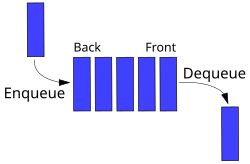Analogy: People in a Line
Think of a queue at:- A bus stop
- A ticket counter
- A fast food restaurant
 The main operations on a queue are:
The main operations on a queue are:
- Enqueue: Adds an element to the back (or “rear”) of the queue.
- Dequeue: Removes the element from the front of the queue.
| Use Case | |
|---|---|
| Print Queue | Documents are printed in the order they were added |
| Task Scheduling | OS or threads manage jobs/tasks using queues |
| Call Center Systems | Incoming calls are held in a queue |
| Data Streaming | Real-time processing of messages/events |
| Keyboard/Input Buffers | Characters typed by users are stored and processed in order |

